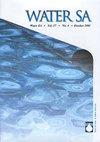Environmental life cycle, carbon footprint and comparative economic assessment of rainwater harvesting systems in schools – a South African case study
IF 1
4区 环境科学与生态学
Q4 WATER RESOURCES
引用次数: 0
Abstract
Rainwater harvesting (RWH) provides a unique opportunity for water conservation. This research aimed to assess the performance of two types of RWH systems (gravity and pump-driven) at a local public school in replacing non-potable water for toilet flushing. The volume of harvested water, efficiency to meet demand, expenses involved and associated environmental burdens were key criteria of performance. Economic considerations included capital costs and return periods, while the environmental aspects encompassed simplified life cycle assessments (LCAs) as well as specific carbon footprints. The gravity-fed system supplied 452.5 kL/annum and covered 31.8% of the demand for flushing water for toilets for the school investigated. The pumped system provided 476.8 kL/annum representing 33.5% of the demand. Together they would be able to supply 65.3% of the demand. The catchment area of these two systems differed and there was no overlap. As expected, the gravity-fed system outperformed the pumped system, both economically and environmentally, because no energy for pumping was needed. In terms of costs, the difference was small, and the payback periods of both systems were similar. However, environmentally, the LCA scores for the pumped system were an order of magnitude higher for all 18 impact categories considered. Carbon footprints showed that in the construction stage both systems have similar footprints. For the operation stage, the comparison was extended, as there were higher energy requirements for the pumped system (about 4 times higher than those from the provision of municipal potable water), but in the same range or lower when compared with other alternative sources of water like groundwater abstraction, recycling of municipal water and desalination. The gravity-fed system required no energy for pumping. This study shows how trade-offs in assessing the overall performance of RWH systems can be considered, leading to better decision making.学校雨水收集系统的环境生命周期、碳足迹和经济比较评估--南非案例研究
雨水收集(RWH)为节水提供了一个独特的机会。这项研究旨在评估当地一所公立学校的两种雨水收集系统(重力式和水泵驱动式)在替代非饮用水冲厕方面的性能。收集的水量、满足需求的效率、涉及的费用以及相关的环境负担是衡量性能的主要标准。经济方面的考虑包括资本成本和回报期,而环境方面则包括简化的生命周期评估(LCA)和具体的碳足迹。经调查,重力供水系统的年供水量为 452.5 千升,占学校冲厕用水需求量的 31.8%。抽水系统的供水量为 476.8 千升/年,占需求量的 33.5%。 两套系统合计可满足 65.3% 的需求。这两个系统的集水区不同,没有重叠。正如预期的那样,重力供水系统在经济和环境方面都优于抽水系统,因为不需要抽水所需的能源。就成本而言,差异很小,两个系统的投资回收期也相近。 但在环境方面,抽水系统的生命周期评估得分在所有 18 个影响类别中都高出一个数量级。碳足迹显示,在施工阶段,两种系统的碳足迹相似。在运行阶段,比较范围扩大了,因为抽水系统的能源需求更高(约为市政饮用水供应的 4 倍),但与其他替代水源(如地下水抽取、市政水循环利用和海水淡化)相比,则在相同或更低的范围内。重力供水系统无需抽水。这项研究表明,在评估 RWH 系统的整体性能时,可以考虑权衡利弊,从而做出更好的决策。
本文章由计算机程序翻译,如有差异,请以英文原文为准。
求助全文
约1分钟内获得全文
求助全文
来源期刊

Water SA
环境科学-水资源
CiteScore
2.80
自引率
6.70%
发文量
46
审稿时长
18-36 weeks
期刊介绍:
WaterSA publishes refereed, original work in all branches of water science, technology and engineering. This includes water resources development; the hydrological cycle; surface hydrology; geohydrology and hydrometeorology; limnology; salinisation; treatment and management of municipal and industrial water and wastewater; treatment and disposal of sewage sludge; environmental pollution control; water quality and treatment; aquaculture in terms of its impact on the water resource; agricultural water science; etc.
Water SA is the WRC’s accredited scientific journal which contains original research articles and review articles on all aspects of water science, technology, engineering and policy. Water SA has been in publication since 1975 and includes articles from both local and international authors. The journal is issued quarterly (4 editions per year).
 求助内容:
求助内容: 应助结果提醒方式:
应助结果提醒方式:


